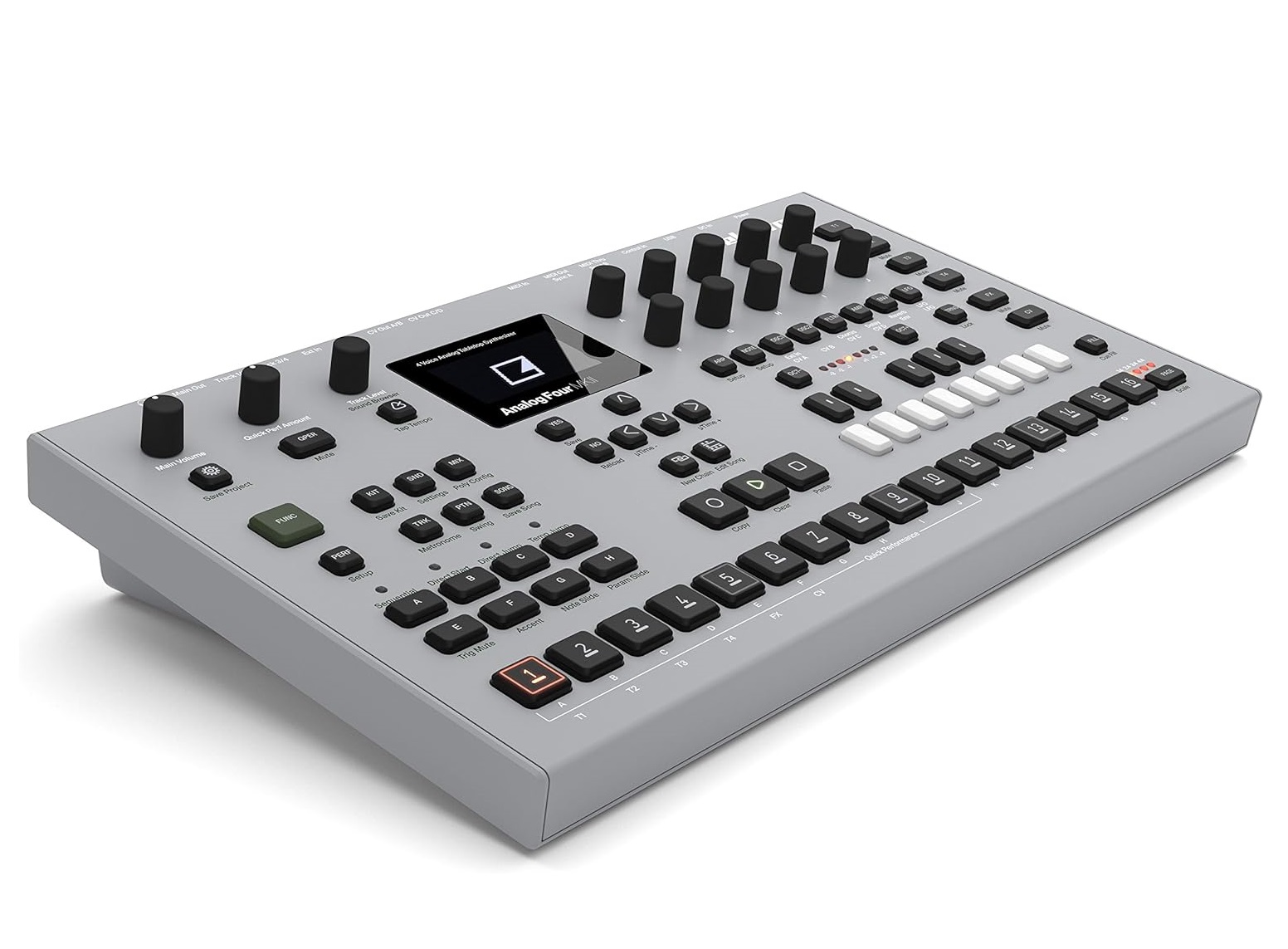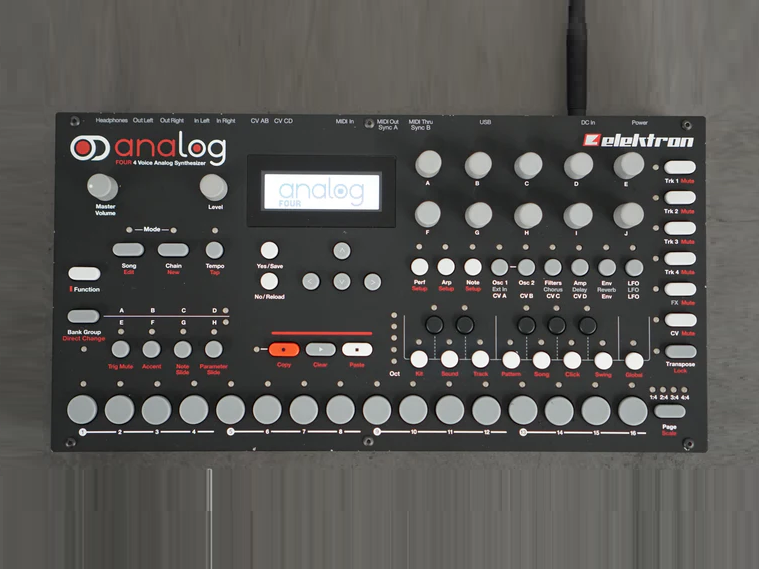Elektron Analog Four
Electronic Instruments
Europe
Between 1901 and present
Video
The Elektron Analog Four is a hybrid analog synthesizer and sequencer that seamlessly blends the warmth of analog sound with the precision of modern digital control. Designed for both studio production and live performances, this powerful instrument allows musicians to create intricate soundscapes, deep basslines, and dynamic leads. Manufactured by the Swedish company Elektron, the Analog Four is known for its four-voice analog synthesis engine, an intuitive sequencer, and deep sound-shaping capabilities. The instrument is widely used by electronic music producers and performers who seek a combination of classic analog tones and modern modulation possibilities.
Type of Instrument
The Elektron Analog Four falls into the synthesizer category, specifically an analog subtractive synthesizer with digital control. Unlike purely digital synths, which generate sound using software-based algorithms, the Analog Four utilizes analog oscillators, filters, and amplifiers to create its sounds. However, the sequencer and modulation routing are managed digitally, allowing for highly intricate sound design and automation possibilities. The combination of analog sound generation with digital sequencing makes the Analog Four unique in the world of synthesizers.
History of Elektron Analog Four
Origin
The Elektron Analog Four originated in Europe, specifically in Sweden, where Elektron was founded in the late 20th century. The Analog Four was first introduced in 2012, marking it as a 21st-century innovation. Elektron has a strong reputation for producing high-quality music instruments, with their early devices like the Machinedrum and Monomachine setting the stage for their later analog-focused designs. The Analog Four was developed during a period when there was a resurgence of interest in analog synthesis, driven by musicians’ desire for the warmth and character of classic analog synthesizers.
Construction
The Elektron Analog Four is built with a robust metal chassis, ensuring durability for both studio and live use. It features a compact desktop form factor, making it portable yet powerful. The interface consists of high-quality rotary encoders, buttons, and an OLED screen, providing detailed visual feedback for sound design and sequencing. The back panel includes MIDI, CV/Gate outputs for modular gear, balanced audio outputs, and a headphone jack. Internally, the Analog Four houses four fully analog voices, each with dual oscillators, multimode filters, and various modulation sources.
Types of Elektron Analog Four
Although Elektron has released multiple versions of the Analog Four, the core design has remained consistent. The two main versions include:
- The original model (Elektron Analog Four MKI (2012))that introduced Elektron’s analog synthesis and sequencing workflow. It features a four-voice analog synth engine, a powerful step sequencer, and external CV/Gate control for modular integration.
- An updated version with improved components, enhanced sound quality, better signal routing, and a redesigned interface with larger buttons and an OLED screen for clearer visibility.
Features
The Elektron Analog Four is packed with advanced features that set it apart from traditional synthesizers. Some of the key features include:
Four Analog Voices: Each voice features two oscillators, noise, two filters, and an analog overdrive circuit.
Elektron Step Sequencer: A powerful and flexible sequencer that allows users to create intricate patterns, modulate parameters per step, and store extensive sequences.
Multimode Filters: Each voice includes a 4-pole ladder filter and a 2-pole multimode filter, offering a wide range of tonal shaping options.
Analog Overdrive and Effects: Built-in analog distortion, delay, reverb, and chorus add depth and texture to the sound.
Performance Mode: Allows users to manipulate multiple parameters simultaneously for expressive live performances.
CV/Gate Outputs: Enables integration with modular synthesizers and other external gear.
Sound Production
The Elektron Analog Four uses a subtractive synthesis engine, where sound is created by generating waveforms from analog oscillators and then shaping them through filters, envelopes, and modulation sources. The two oscillators per voice can produce saw, square, sine, and triangle waves, with additional options for pulse-width modulation and sync. The filters allow precise tonal sculpting, while the overdrive circuit adds warmth and grit to the sound. Modulation sources like LFOs and envelopes provide movement and complexity, making it possible to create everything from deep basslines to evolving pads and sharp leads.
Playing Methods
Musicians can play the Analog Four using various methods, depending on their workflow and preference. The Analog Four can be played in real-time using its built-in keyboard or an external MIDI controller. The onboard Elektron sequencer allows users to input notes step-by-step, perfect for electronic music production. A unique Elektron feature that enables different settings per step, allowing for complex sequences with dynamic changes. Built-in arpeggiation functions create rhythmic patterns and melodic movement. It can be controlled via MIDI or CV/Gate signals, allowing integration into larger studio setups or modular systems.
Roles in Music
The Elektron Analog Four plays a significant role in various genres and musical applications due to its versatility. Some of its key roles include:
Electronic Music Production: Used extensively in techno, house, ambient, and experimental music.
Film Scoring and Sound Design: Its deep modulation capabilities make it suitable for creating cinematic soundscapes and textures.
Live Performance: The performance mode and sequencer make it an excellent tool for live electronic acts.
Modular Integration: Works seamlessly with Eurorack and other modular synth systems, expanding its creative potential.
Hybrid Studio Setups: Bridges the gap between analog and digital workflows, making it a popular choice for modern producers.
The Elektron Analog Four is a powerful and innovative synthesizer that merges the best of analog warmth with digital precision. Its four-voice architecture, advanced sequencer, and deep modulation options make it an essential tool for musicians, producers, and sound designers. Whether used in the studio, on stage, or as part of a modular setup, the Analog Four continues to be a versatile and inspiring instrument in the world of electronic music. With ongoing updates and enhancements, Elektron ensures that the Analog Four remains a staple for those seeking expressive, high-quality analog synthesis with cutting-edge digital control.
FAQ
What materials is the Elektron Analog Four made of?
The Elektron Analog Four is primarily made of a durable metal chassis with high-quality plastic and rubberized knobs. The buttons are backlit for visibility, and the OLED screen ensures clear readability. Internal components include premium-grade analog circuits for warm sound generation. The sturdy build makes it reliable for both studio and live performances.
What are the main characteristics of the Elektron Analog Four?
The Elektron Analog Four is a four-voice analog synthesizer with digital control, featuring deep modulation options. It includes an intuitive sequencer, CV/Gate connectivity for external gear, and effects like reverb, delay, and chorus. Its sound-shaping capabilities allow for intricate and evolving textures. The unit is compact, portable, and perfect for professional sound design.
How is the Elektron Analog Four constructed?
The Analog Four is constructed with a rugged aluminum housing, designed to withstand heavy use. The analog signal path ensures rich and warm sound, while digital control allows precise parameter adjustments. Each component, from the encoders to the output jacks, is crafted for long-term durability. The hybrid analog-digital architecture provides deep programming flexibility.
 Links
Links
References
 Similar
Similar
Instruments
Other Instrument
Categories



















